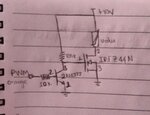Rikr09
Member level 3
Hello!
I have a pair of these valve:s https://kellypneumatics.com/download_files/MidPVspec.pdf. We tried to control them using a PWM signal from a Raspberry Pi but this is not working causing some vibrations and notable fluctuations on the output. So i decided to write you to help us with a configuration to control them.
Attached the image of the circuit that im using for now:

Thanks for your attention.
I have a pair of these valve:s https://kellypneumatics.com/download_files/MidPVspec.pdf. We tried to control them using a PWM signal from a Raspberry Pi but this is not working causing some vibrations and notable fluctuations on the output. So i decided to write you to help us with a configuration to control them.
Attached the image of the circuit that im using for now:

Thanks for your attention.